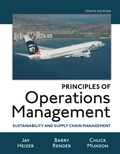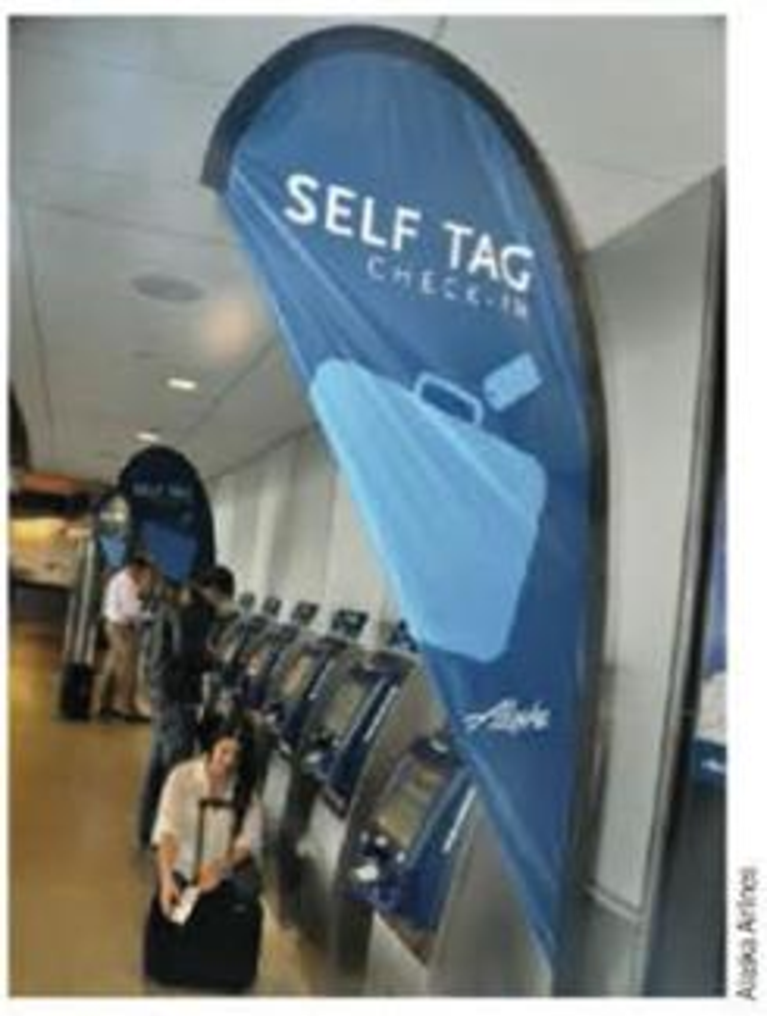
Alaska Airlines: 20-Minute Baggage Process—Guaranteed!
Alaska Airlines is unique among the nine major U.S. carriers not only for its extensive flight coverage of remote towns throughout Alaska (it also covers the U.S., Hawaii, and Mexico from its primary hub in Seattle). It is also one of the smallest independent airlines, with 10,300 employees, including 3.000 flight attendants and 1.500 pilots. What makes it really unique, though, is its ability to build state-of-the-art processes, using the latest technology, that yield high customer satisfaction. Indeed, J. D. Power and Associates has ranked Alaska Airlines highest in North America for seven years in a row for customer satisfaction.
Alaska Airlines was the first to sell tickets via the Internet, first to offer Web check-in and print boarding passes online, and first with kiosk check-in. As Wayne Newton. Director of System Operation Control, states, “We are passionate about our processes. If it’s not measured, it’s not managed.”
One of the processes Alaska is most proud of is its baggage handling system. Passengers can check in at kiosks, tag their own bags with bar code stickers, and deliver them to a customer service agent at the carousel, which carries the bags through the vast underground system that eventually delivers the bags to a baggage handler. En route, each bag passes through TSA automated screening and is manually opened or inspected if it appears suspicious. With the help of bar code readers, conveyer belts automatically sort and transfer bags to their location (called a “pier”) at the tarmac level. A baggage handler then loads the bags onto a cart and takes it to the plane for loading by the ramp team waiting inside the cargo hold. There are different procedures for “hot bags” (bags that have less than 30 minutes between transfer) and for “cold bags” (bags with over 60 minutes between plane transfers). Hot bags are delivered directly from one plane to another (called “tail-to-tail”). Cold bags are sent back into the normal conveyer system.
The process continues on the destination side with Alaska’s unique guarantee that customer luggage will be delivered to the terminal’s carousel within 20 minutes of the plane’s arrival at the gate. If not, Alaska grants each passenger a 2,000 frequent-flier mile bonus!
The airline’s use of technology includes bar code scanners to check in the bag when a passenger arrives, and again before it is placed on the cart to the plane. Similarly, on arrival, the time the passenger door opens is electronically noted and bags are again scanned as they are placed on the baggage carousel at the destination tracking this metric means that the “time to carousel” (TTC) deadline is seldom missed. And the process almost guarantees that the lost bag rate approaches zero. On a recent day, only one out of 100 flights missed the TTC mark. The baggage process relies not just on technology, though. There are detailed, documented procedures to ensure that bags hit the 20-minute timeframe. Within one minute of the plane door opening at the gate, baggage handlers must begin the unloading. The first bag must be out of the plane within three minutes of parking the plane. This means the ground crew must be in the proper location with their trucks and ramps in place and ready to go.
Largely because of technology, flying on Alaska Airlines is remarkably reliable—even in the dead of an Alaska winter with only two hours of daylight. 50 mph winds, slippery runways, and low visibility. Alaska Airlines has had the industry’s best on-time performance, with 87% if its flights landing on time.

Discussion Questions*
1. Prepare a flowchart of the process a passenger’s bag follows from kiosk to destination carousel. (See Example 2 in Chapter 6 for a sample flowchart.) Include the exception process for the TSA opening of selected bags.
2. What other processes can an airline examine? Why is each important’?
3. How does the kiosk alter the check-in process?
4. What metrics (quantifiable measures) are needed to track baggage?
5. What is the role of scanners in the baggage process?
*You may wish to view the video that accompanies this case before addressing these questions.
Want to see the full answer?
Check out a sample textbook solution
Chapter 7 Solutions
EBK PRINCIPLES OF OPERATIONS MANAGEMENT
- a. The average aggregate inventory value of the product if Ruby-Star used vendor 1 exclusively is $enter your response here. (Enter your response as a whole number.) b. The aggregate inventory value of the product if Ruby-Star used vendor 2 exclusively is shown below. c. How would your analysis change if average weekly demand increased to 160 units per week? The aggregate inventory values are shown below.arrow_forwarda. What order quantity should be used? lures. (Enter your response rounded to the nearest whole number.) b. What reorder point should be used? (Enter your response rounded to the nearest whole number.) c. What is the total annual cost for this inventory system? (Enter your response rounded to two decimal places)arrow_forwardOakwood Hospital is considering using ABC analysis to classify laboratory SKUS into three categories: those that will be delivered daily from their supplier (Class A items), those that will be controlled using a continuous review system (B items), and those that will be held in a two bin system (C items). The following table shows the annual dollar usage for a sample of eight SKUS. Fill in the blanks for annual dollar usage below. (Enter your responses rounded to the nearest whole number.) SKU Unit Value Demand (units) Annual Dollar Usage 1 $1.10 30,000 $ 2 $0.02 125,000 $ 3 $0.20 65,000 S 4 $0.02 1,100 SA 5 $1.40 150 SA 678 $4.10 900 $ $0.80 350 $ $0.55 80 EA $arrow_forward
- Dyson, a high-tech home appliance maker, has cut ties with Malaysian supplier ATA IMS Bhd following an audit of the company's labour practices and allegations by a whistleblower. ATA is already under US investigation over forced labour allegations. Dyson has terminated its contracts and is in talks with its customer over the audit findings. ATA, which produces parts for Dyson's vacuum cleaners and air purifiers, tumbled 30% to its lowest since April 2020. The termination is a significant blow for Malaysia, a major electronics manufacturing hub, which has faced scrutiny this year over claims of abusive working and living conditions. Dyson terminated the relationship with six months' contractual notice, hoping it would give ATA the impetus to improve and enable an orderly withdrawal in the interests of the workers they employ. Former ATA worker Dhan Kumar Limbu was beaten by police in Malaysia after sharing information about conditions at the factory with activists. ATA denied all…arrow_forwardQuestion 4 (25 Marks) Discuss how developing internal performance measures to track the performance of supplier development, can create efficiency for Pick n Pay.arrow_forwardLeadership and people Earlier this year, Pick n Pay actioned the first priority of the plan: the introduction of a new, simplified and seasoned leadership team with proven track records. The team has already implemented strengthened structures, including establishing regional trading areas with local decision-making, with clear sight of strong long-term succession Each operating region now has a regional buying team and store management team in place to meet specific customer needs particular to that region, while also increasing staff training and productivity for an overall improved store experience. Reset the store estate To create a more sustainable supermarket business, the Group is resetting its store estate to minimise losses by creating a smaller but more profitable Pick n Pay store estate. The plan is to leverage the strength of its multi-format model with strategic conversions to lift store profitability: selected Pick n Pay stores will be converted to Boxer, where customer…arrow_forward
- Question 3 (25 Marks) Elaborate on how Pick n Pay could use information technology and ERP systems across the company and their suppliers to improve their operating model? Question 4 (25 Marks)arrow_forwardQuestion 2 (25 Marks) Discuss how you would "reset the store estate" to remain competitive and relevant in the market? Question 3 (25 Marks)arrow_forwardWhat should leaders do after conducting an employee survey? take immediate action on results take at least 6 months to review the results to make sure the leader understands them review them immediately, but do not take action right away keep results confidential from employeesarrow_forward
- One of the best ways to encourage teamwork is to: continually promote from outside of the department recognize employees who focus on their personal performance goals only reward employees who complete their own tasks and also assist with problems outside of their department discuss individual performance issues at staff meetingsarrow_forwardWhat can happen if a leader doesn't encourage teamwork? team members will support each other more the environment can become overly competitive and hostile turnover will descrease team members become more motivatedarrow_forwardunderstand 4 Classwork LSC Drag the name of the figure of speech to its example. 12 February 2025 personification Onomatopoeia Simile Metaphor Hyperbole Onomatopoeia metaphor 1. He tried to help but his legs were wax. Metaphor 2. The man flights like a lion on the soccer field. Simile 3. The books fell on the table with a loud thump. Onomatopoeia 4. Rita heard the last piece of pie calling her name. Personification 5. The rustling leaves kept me away. Personification 6. Kisses are the flowers of affection. 7. He's running faster than the windarrow_forward
 Purchasing and Supply Chain ManagementOperations ManagementISBN:9781285869681Author:Robert M. Monczka, Robert B. Handfield, Larry C. Giunipero, James L. PattersonPublisher:Cengage Learning
Purchasing and Supply Chain ManagementOperations ManagementISBN:9781285869681Author:Robert M. Monczka, Robert B. Handfield, Larry C. Giunipero, James L. PattersonPublisher:Cengage Learning- MarketingMarketingISBN:9780357033791Author:Pride, William MPublisher:South Western Educational Publishing
 Practical Management ScienceOperations ManagementISBN:9781337406659Author:WINSTON, Wayne L.Publisher:Cengage,
Practical Management ScienceOperations ManagementISBN:9781337406659Author:WINSTON, Wayne L.Publisher:Cengage,




